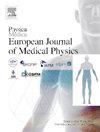Improved patient-specific quality assurance for VMAT on film measurement with 2.5D gamma analysis
IF 3.3
3区 医学
Q1 RADIOLOGY, NUCLEAR MEDICINE & MEDICAL IMAGING
Physica Medica-European Journal of Medical Physics
Pub Date : 2025-05-29
DOI:10.1016/j.ejmp.2025.105019
引用次数: 0
Abstract
Purpose
This study proposed a “2.5D gamma analysis” method for patient-specific quality assurance (PSQA) in volumetric modulated arc therapy (VMAT) using film measurements.
Methods
A custom-designed water phantom was used, consisting of a main body and an insert box, each with a wall thickness of 10 mm, and filled with water. The insert box contained a film holder designed to accommodate several radiochromic films. The holder consisted of four separate 2 mm-thick plates and a cover, allowing the positioning of one to five films. For consistency, three films were used per case, positioned at 0 and ± 2 mm. Quasi-volumetric data were generated from the measured Gafchromic film data at various positions using B-spline interpolation, producing additional data points at 0.5 mm intervals. Five spine SBRT cases were analyzed by comparing 2.5D and 2D gamma analyses using different criteria and dose thresholds.
Results
The 2.5D gamma analysis showed higher gamma pass rates compared to the 2D analysis, with an average gamma pass rate of 98.6 % for the 2.5D analysis and 87.4 % for the 2D analysis, using 3 %/1 mm gamma criteria with a 5 % dose threshold. This represented an 11.2 % point increase in the gamma pass rate.
Conclusions
The 2.5D gamma analysis provided higher gamma pass rates than the 2D analysis for film measurements, providing increased confidence in the accuracy of the spine VMAT treatment plan.
通过2.5D伽马分析改善了VMAT对胶片测量的患者特异性质量保证
目的:本研究提出了一种“2.5D伽马分析”方法,用于体积调制电弧治疗(VMAT)中使用薄膜测量的患者特异性质量保证(PSQA)。方法采用定制设计的水模,由一个主体和一个插入盒组成,每个插入盒的壁厚为10 mm,填充水。插入盒中装有一个胶片架,用于容纳几张放射线变色胶片。支架由四个独立的2毫米厚的板和一个盖子组成,允许定位一到五张胶片。为了一致性,每个病例使用三层膜,定位在0和±2毫米。利用b样条插值从不同位置测量的Gafchromic薄膜数据生成准体积数据,每隔0.5 mm产生额外的数据点。采用不同的标准和剂量阈值对5例脊柱SBRT病例进行2.5D和2D伽马分析比较。结果采用3% /1 mm γ标准,剂量阈值为5%,2.5D γ分析的平均通过率为98.6%,2D分析的平均通过率为87.4%,2.5D分析的通过率高于2D分析。这表明伽马通过率增加了11.2%。结论2.5D伽马分析比2D分析提供了更高的伽马通过率,为脊柱VMAT治疗计划的准确性提供了更高的信心。
本文章由计算机程序翻译,如有差异,请以英文原文为准。
求助全文
约1分钟内获得全文
求助全文
来源期刊
CiteScore
6.80
自引率
14.70%
发文量
493
审稿时长
78 days
期刊介绍:
Physica Medica, European Journal of Medical Physics, publishing with Elsevier from 2007, provides an international forum for research and reviews on the following main topics:
Medical Imaging
Radiation Therapy
Radiation Protection
Measuring Systems and Signal Processing
Education and training in Medical Physics
Professional issues in Medical Physics.

 求助内容:
求助内容: 应助结果提醒方式:
应助结果提醒方式:


